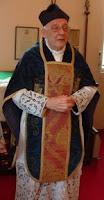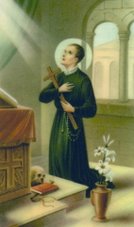
 Last Pentecost, we were fortunate enough to be present for a magnificent sung Mass at Harvington Hall. I was also fortunate enough to have my camera with me, and was quickly prompted to get lots of photos of an unusual and historic priestly vestment which was generously donated for use at this Mass. It is the 'Catherine of Aragon' Chasuble!
Last Pentecost, we were fortunate enough to be present for a magnificent sung Mass at Harvington Hall. I was also fortunate enough to have my camera with me, and was quickly prompted to get lots of photos of an unusual and historic priestly vestment which was generously donated for use at this Mass. It is the 'Catherine of Aragon' Chasuble!Since that day, I have been eager to find out more about the history of the Chasuble, which you can see Fr David Higham wearing. Now, in the latest edition of Mass of Ages, David Hurd writes all about it (published with a B&W copy of my above photo):
This vestment was bequeathed to the Catholic Church in Ludlow in 1958 by Sir Walter Blount of Mawley Hall in Shropshire.
The Blount family believed it to have been a gift from Catherine of Aragon to Elizabeth Blount, her Lady-in-Waiting. Recent research suggests more accurately that it was pieced together after Catherine's death in January 1536. In her will she asks that "Her gowns (of velvet and cloth of gold) held by King Henry VIII be made into Church Vestments."
Repair and restoration work was carried out by Mrs Monica Meek of St Peter's Parish in Ludlow. She died in 2006 aged 96 and the chasuble was worn by the celebrant at her Requiem Mass.
Catherine's biographer, F. Claremont (1939), states that "among Catherine's embroidery her emblem, the pomegranate, features prominently." The cloth of gold used for the cross piece on the vestment was made in Florence in the period 1470-1500 and imported into Spain; it then came with Catherine to England and to Ludlow in 1501. The cross piece is made up from cuttings of the original garment to prominently feature the pomegranates.
Catherine's will requested that the furs from her garments be given to her daughter Mary who probably had the vestment made and to which she added her mother's embroidery work.
 The shreds of devotion which remained in our country began with Catherine, and perhaps testify to her noble and tragic place in all this. Before dying, she wrote a final plea to the schismatic king, now already remarried and treating her with ignominy:
The shreds of devotion which remained in our country began with Catherine, and perhaps testify to her noble and tragic place in all this. Before dying, she wrote a final plea to the schismatic king, now already remarried and treating her with ignominy:Please keep Fr Higham in your prayers, after having suffered a stroke last week. May he make a steady and full recovery.My most dear lord, King and husband,
The hour of my death now drawing on, the tender love I owe you forceth me, my case being such, to commend myself to you, and to put you in remembrance with a few words of the health and safeguard of your soul which you ought to prefer before all worldly matters, and before the care and pampering of your body, for the which you have cast me into many calamities and yourself into many troubles. For my part, I pardon you everything, and I wish to devoutly pray God that He will pardon you also. For the rest, I commend unto you our daughter Mary, beseeching you to be a good father unto her, as I have heretofore desired. I entreat you also, on behalf of my maids, to give them marriage portions, which is not much, they being but three. For all my other servants I solicit the wages due them, and a year more, lest they be unprovided for. Lastly, I make this vow, that mine eyes desire you above all things.
Katharine the Queen.


















This is indeed a beautiful late-medieval vestment but, despite the family legend, the decoration of powdered pomegranates does not necessarily mean that it is linked with Queen Katherine of Aragon. Pomegranates were used widely in late-medieval embroidery as a symbol of life and their use was rarely heraldic. It might well be associated with the Queen but there is no documentary proof. The parish priest at Ludlow presses the evidence too far.
ReplyDeleteWhat liturgical color is that vestment supposed to be? It seems to be dark blue with a red cross, so I was curious. Really beautiful; I wish they'd make new vestments in that style.
ReplyDeleteJohnny boy wrote: "I wish they'd make new vestments in that style."
ReplyDeleteThey do Johnny:
http://saintbedestudio.blogspot.com
Without knowing too much either of English history or the meaning of certain symbols, I'd like to point out that the pomegranate was, indeed, a badge used by Queen Katherine. Please refer to any good book on the subject of Royal Heraldry or Royal Badges (the College of Arms gives a list of recommended reading on its website). Badges are not "full" coats of arms, but their use can be granted by the College of Arms to this day.
ReplyDelete